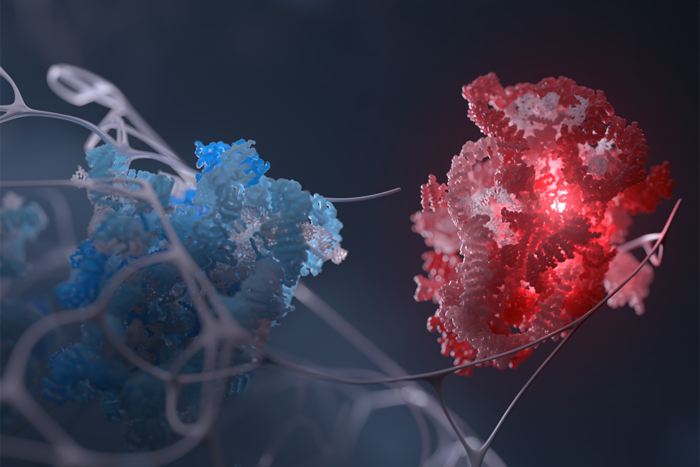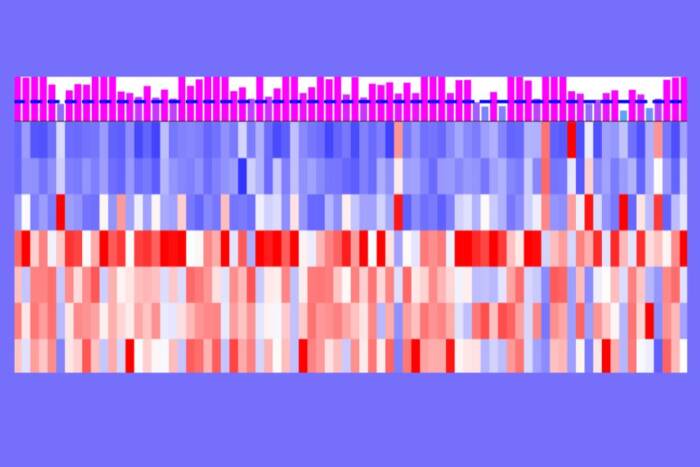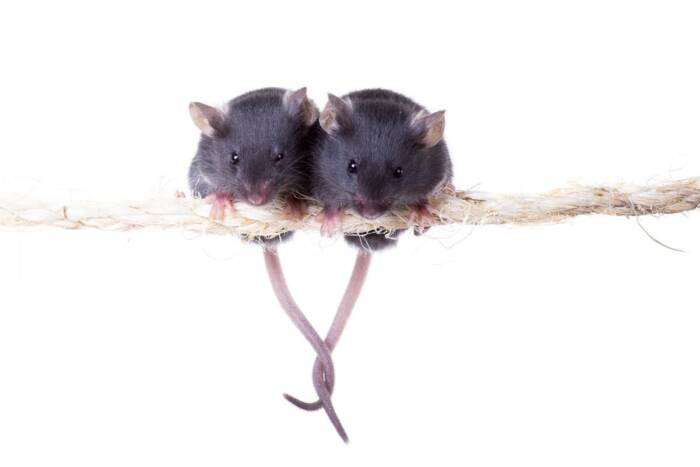The making of a fat cell
Researchers identify a key ingredient in development of body fat

(clockwise from top left) Mohamed Guermah, Mitsuhiro Ito, Kai Ge and Annika Wallberg of the Roeder lab.
The future of a young body cell is filled with uncertainties. Will it mature into a red blood cell and carry oxygen to remote tissues? Or might it become a liver cell and help rid the body of dangerous toxins? Ultimately, its destiny depends on a set of molecular signals that activate one of several possible cellular programs.
Now, in the May 30 issue of Nature, researchers at The Rockefeller University report the existence of a protein “switch” specific for the “fat” program — without this protein, called TRAP220, young cells cannot mature into adult fat cells.
“We have discovered an indispensable protein in the fat-making process,” says postdoc Kai Ge, first author of the Nature paper.
The body regularly converts fibroblasts – young cells that have the potential to become fat, muscle or bone — into fat cells. This normal body process, called adipogenesis, occurs throughout life as a means to store nutrients and protect against cold.
Because adipogenesis breaks down in several diseases, including diabetes, heart disease and cancer, understanding this protein switch may one day allow scientists to tweak it to treat these conditions.
The recent Rockefeller research demonstrates that TRAP220 — a component of a giant mammalian protein complex called the TRAP/Mediator—is absolutely essential for mice cells called embryonic fibroblasts to become fat cells. Furthermore, the researchers show that this same protein is not required for the development of muscle cells, thereby indicating that it is indeed specific for adipogenesis.

- In order for a young fibroblast cell to mature into a fat cell certain fat-specific genes must be transcribed or “switched-on.” But before this can occur, a precise series of molecular events must take place in the cell’s nucleus, beginning with the binding of a small fatty acid molecule to a protein called PPARγ2 – a type of gene activator called a “nuclear hormone receptor.” This bound protein binds to a specific patch of DNA together with a partner protein, which then signals for the recruitment of the giant TRAP Mediator multiprotein complex. The subsequent binding of one of the Mediator’s subunits, called TRAP220, to PPARγ2 triggers the recruitment of the general transcription machinery, and finally transcription – and the production of fat-specific proteins – begins. Previously, the Roeder lab showed that the tumor suppressor protein P53 binds to the TRAP80 subunit of the TRAP Mediator.
The TRAP/Mediator, also referred to as the “human mediator,” belongs to a class of proteins called coactivators. Previously, scientists knew that these proteins were required for turning most genes on, but, until now, it wasn’t clear whether they also played cell-specific roles in physiological processes, such as adipogenesis.
“Our findings suggest that different components of the human mediator regulate the formation of different cell types,” says Robert G. Roeder, head of the Laboratory of Biochemistry and Molecular Biology at Rockefeller and principal author of the Naturepaper.
“By allowing genes to be turned on in a cell-specific manner, this giant coactivator provides complex organisms such as humans with an added level of control over physiological processes,” says Roeder.
Cells are equal to sum of their proteins
The various cell types constituting our bodies can be distinguished from one another by the specific proteins they produce. For example, fat cells manufacture an enzyme, lipase, to break down fats into smaller pieces when the body needs energy. Muscle cells, on the other hand, produce an abundance of actin, a protein that enables muscle contraction. Thus, when the body instructs a fibroblast to become a fat cell, certain genes must be switched on, such as the gene for lipase.
This vital life process of switching on, or “reading,” genes is called transcription — the basis of which has been the subject of intense research in the Roeder lab for nearly 30 years. Beginning with Roeder’s initial discovery in 1969 of the human “gene-reading” machines or RNA polymerases, the Roeder lab has gone on to elucidate dozens of the proteins involved in switching genes on — including the coactivator known as the human mediator.
Coactivators act together with two other classes of proteins — activators and the general transcription machinery, which includes RNA polymerase — to turn genes on. First, activators bind to a specific stretch of DNA in frontof a given gene; second, bound activators recruit coactivators to the site; then, bound coactivators summon the general transcription machinery to the scene, and finally the RNA polymerase begins “reading” the gene. In essence, then, coactivators are like bridges that allow activators access to the general transcription machinery.

Rockefeller researchers led by Robert G. Roeder discovered an indispensable protein in the fat-making process. Young mouse cells called fibroblasts normally mature into fat cells (left) containing lipid droplets (red). But without this protein, called TRAP220, they cannot become fat cells.
But it has remained unclear whether coactivators, in addition to their role as mandatory transcription proteins, also function in a cell-specific manner. The report in Nature by Roeder and colleagues is one of the first to show that coactivators do indeed play a cell-specific role in such physiological processes as adipogenesis.
Turning on “fat” program
Previously, scientists knew that some small fatty acid molecules could trigger the differentiation of an embryonic fibroblast into a fat cell by binding to a nuclear hormone receptor called PPARgamma2. A nuclear hormone receptor is a type of transcription activator that binds to and turns on specific target genes once a “ligand,” in this case a fatty acid molecule, binds to it. Researchers also had shown that PPARgamma2 binds to TRAP220, a component of the human mediator, but they did not know the complete physiological consequences of this binding.
To answer this question, the Rockefeller researchers engineered mice embryonic fibroblast cells to lack the TRAP220 protein. Normally, the scientists can coax these primitive cells into becoming fat cells by adding PPARgamma2. But when they tried this experiment with the mutant cells missing TRAP220, they saw no change. In contrast, when they added TRAP220 back into the fibroblasts, fat cells did arise. Together these findings show that TRAP220 is absolutely essential for making fat.
The researchers then repeated the experiment with a protein that stimulates the formation of muscle instead of fat. This time, muscle cells arose even in the absence of TRAP220, thereby suggesting that this particular component of the human mediator is specific for adipogenesis.
But the human mediator may be even more complicated. In a paper published in the Proceedings of the National Academy of Sciences in March, Roeder and colleagues, including graduate fellow and first author Yun Kyoung Kang, showed that TRAP220 also specifically binds to the estrogen hormone receptor and enhances its activity. To explain this interaction, the researchers hypothesize that specific parts of each component of the mediator, not just the various components themselves, regulate different physiological processes.
Thus, the profile emerging of the human mediator is that of a giant multicontrol panel, capable of integrating a diverse array of signals into one plan of action. Activators are like keys that must find the right lock on this panel in order to gain access to the general transcription machinery and subsequently switch on target genes
Says Roeder, “Evolution created coactivators to meet the needs of increasingly complex cells.”
This research was funded by grants from the National Institutes of Health and the Charles H. Revson Foundation.


